-
Car Reviews
- All reviews
- Midsize SUVs
- Small cars
- Utes
- Small SUVs
- Large SUVs
- Large cars
- Sports SUVs
- Sports cars
- Vans
Latest reviews
- Car News
-
Car Comparisons
Latest comparisons
- Chasing Deals
With 4500kg towing, massive payload, heavy-duty everything and smart features ready for extreme work, can Super Duty unseat the iconic Land Cruiser 79 Series?
Have you ever stood beside a heavyweight boxer? They’re the same as we normal folk, except everything – height, legs, arms, head, hands – are about 30 to 50 percent bigger. Like they’ve been upsized.
It’s the same with Ford’s new Ranger Super Duty. You can tell it’s the old familiar Ranger, but has undertaken a solid course of steroids, gym work and altitude training. This mega-Ranger is rugged, tall, wide, imposing and very much programmed for manual labour.

If a Ranger Raptor’s the bravado-filled extrovert, the new Super Duty’s your no-nonsense toiler ready and willing to grind out a result on any surface in any weather.
We’ve covered the Super Duty’s specs here, but in short, it launches with three cab-chassis body styles: a Single-Cab (two-door, two-seat) from $82,990; Super-Cab (tiny hinged rear doors) from $86,490; and Double-Cab (four-door, five-seat) from $89,990, all before on-roads and tray costs.
A double-cab pickup with style-side tub is expected by mid-2026; it’ll be pricier again, but will be the target for hard-core recreational users. These first Super Duty Cab-Chassis come in only one workman-like grade – think cloth seats and vinyl floor – but the pickups should give scope for more grades and cabin niceties.
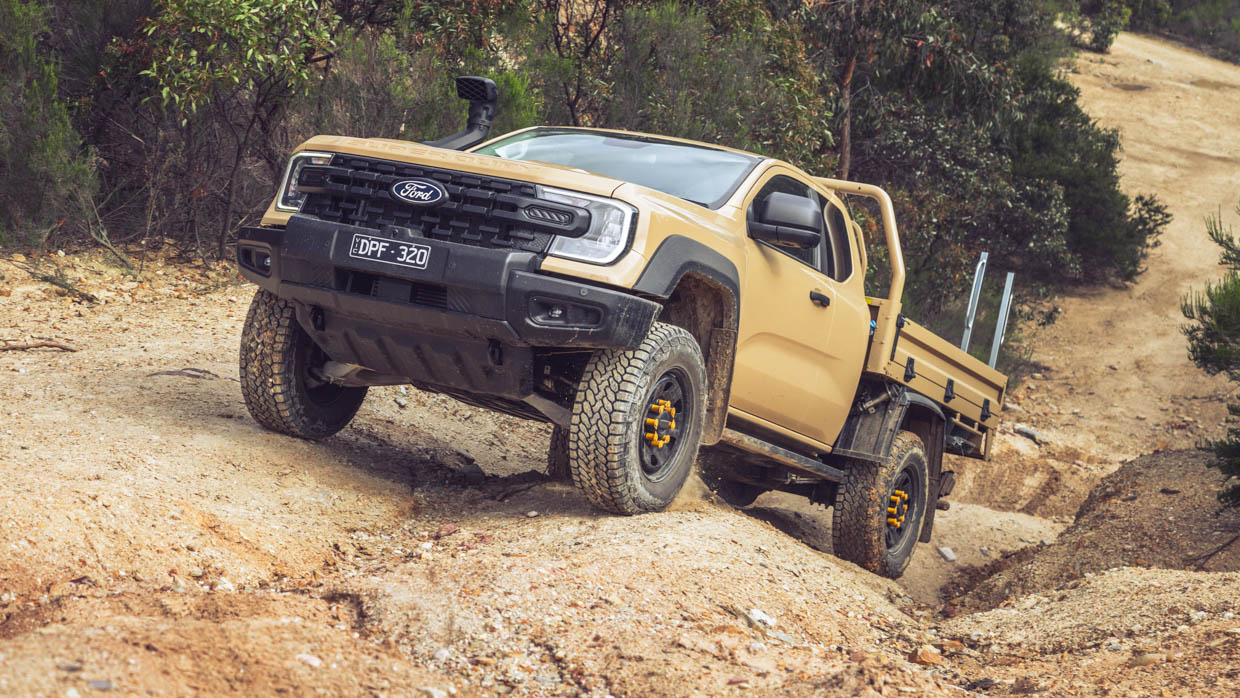
Why does Ranger Super Duty exist? To fulfill true hard-core work and lifestyle duties. It tows 4500kg, has GVM of 4500kg and GCM of 8000kg. It appears a no-brainer to opt for a Super Duty rather than performing a GVM upgrade and adding lots of off-road or work kit to a garden variety Ranger.
There’s heavy-duty everything under and above to handle the toughest tests, as it’s aimed at those working or living in our harsh Outback, at cattle stations, mines, rural worksites or sprawling farms. In such places, your vehicle can’t let you down or work must stop. At worst, dire situations could well put your life in jeopardy.
It’s why the uber-reliable Toyota Land Cruiser 70 Series is weapon of choice in these wildest of environments, especially the 79 Series pickup. But that old soldier’s basically the same vehicle it was back in 1984 – uncomplicated and dependable but short on modern comfort and tech – and as Toyota’s dropped the 4.5L V8 and left buyers with only 2.8L HiLux-engined ones.

So the timing of this Ranger Super Duty’s arrival with its 3.0L V6 turbo-diesel is well judged. Bigger displacement and two extra cylinders could tip things in Ford’s favour with buyers.
The Ford “Lion” V6 and its 10-speed auto’s reliability? There are question marks which we’ve explored elsewhere, but we’ve not got a crystal ball, so must only judge on its performance during the launch test.
Which was exhaustive. Hundreds of kilometres on highway and rural sealed roads, then unsealed tracks, gnarly off-road courses, heavy towing and scaling mountains. Ford Australia absolutely allowed us to sample the hulking Super Duty in extreme ways.
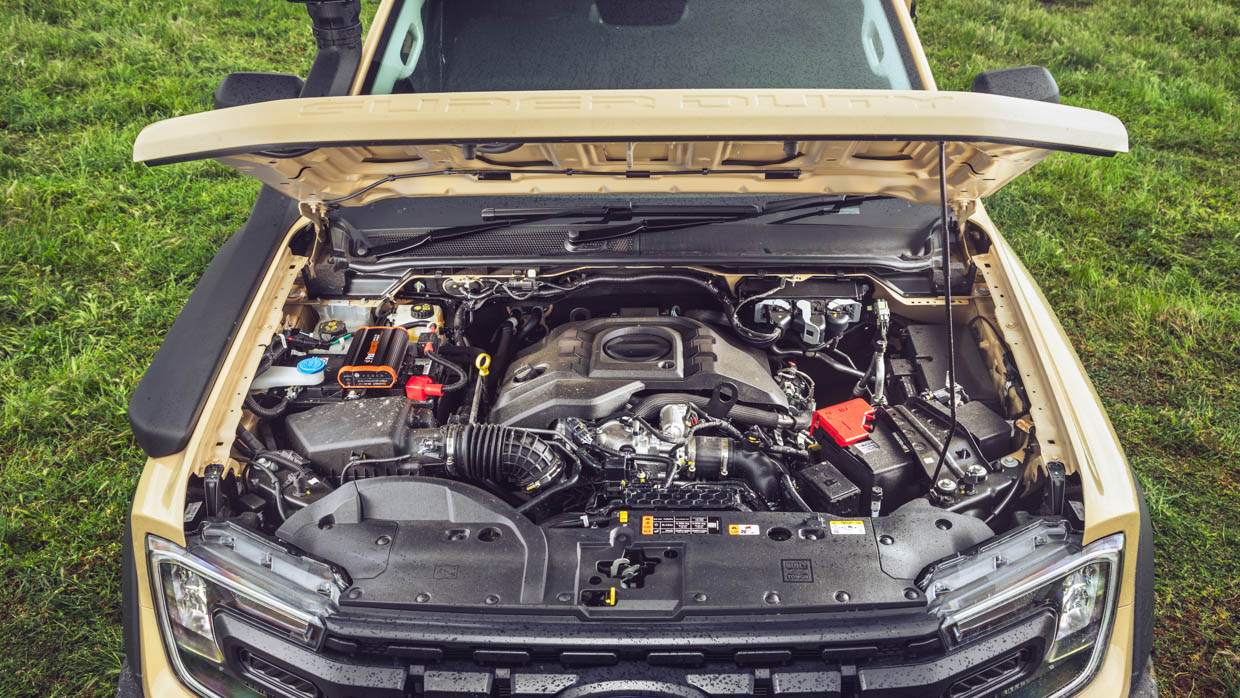
First question I received from Ranger owners and enthusiasts was “Does it drive like a Ranger?”
There’s clear interest in this heavy-duty version, but many wouldn’t want to sacrifice their normal Ranger’s excellent (for a ute) overall driving manners.
In short, it’s not as far off a regular Ranger as I expected it would be. On the bitumen, and despite being unladen, the SD’s handling and body control proved reassuringly poised and safe, if speeds were kept sensible.
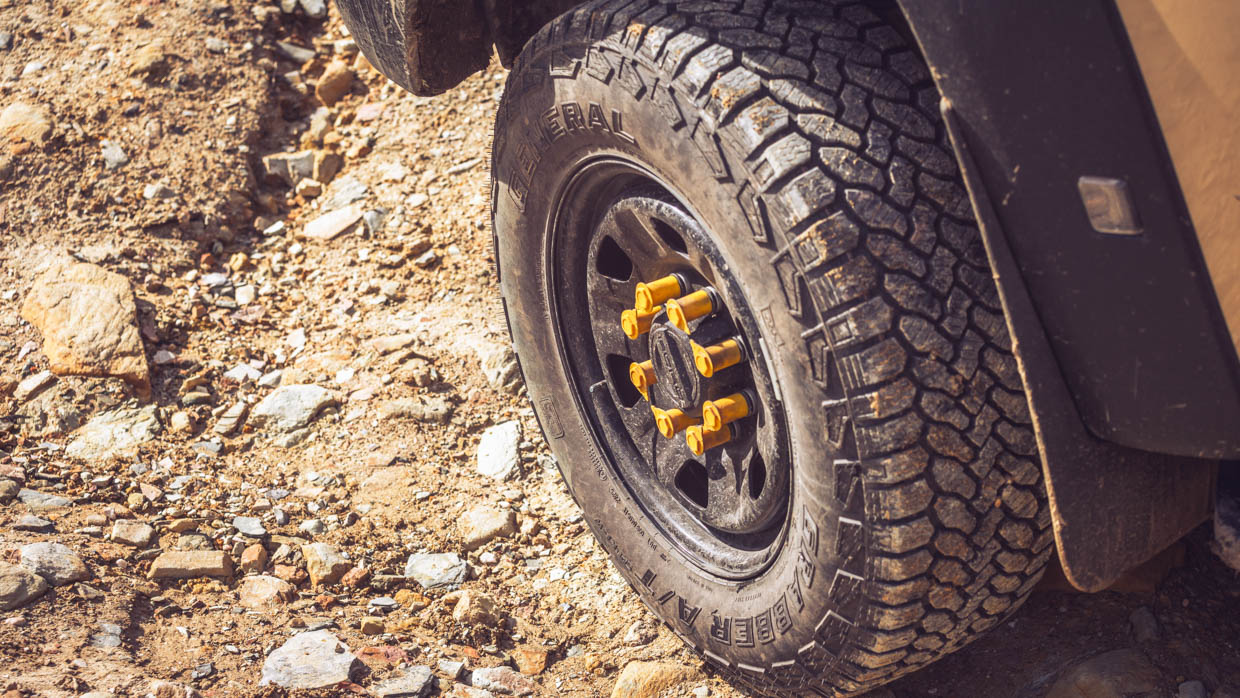
It does feel bigger on the road. The uprated springs and shocks, plus 33-inch all-terrain General Grabber tyres, give ground clearance between 295mm and 299mm depending on body style – considerably up from the regular Ranger’s 234mm.
It has the same footprint as a regular Ranger, but a wider track (1710mm) to help dynamics compromised by its taller ride height. Ford’s added wider, squared off wheel arches to suit, which accommodate the chunkier tyres. Lots of space under those arches for aftermarket wheels and rubber, plus to help deal with the mud and muck likely to be fired into them.
Blessedly, the SD doesn’t feel as lumbering as a full-size American pickup like Ford’s F-150 (surely sales of that will tumble with this new Ranger’s arrival?), while it feels far less agricultural to drive than the ancient Land Cruiser 79 Series.

Disc brakes all round give ample bite, steering has fair feel, and as it retains independent front suspension and not a more hard-core solid axle, overall comfort, feel and suppleness from the front end make it tolerable as an everyday driver.
The rear has seriously hard-core leaf springs to handle the potential payload: 1982kg the single-, 1885kg the Super- and 1825kg the double-cab body style. That’s roughly half a tonne above a Toyota 79 Series’ numbers.
Only six percent of a regular Ranger’s frame is shared with this SD, and its more rigid, robust chassis and suspension means road bumps and potholes translate into sharp hits at low speeds. Some load in the tray (most users will have this at all times) would settle things somewhat, and our test showed the ride felt more compliant the faster you went.
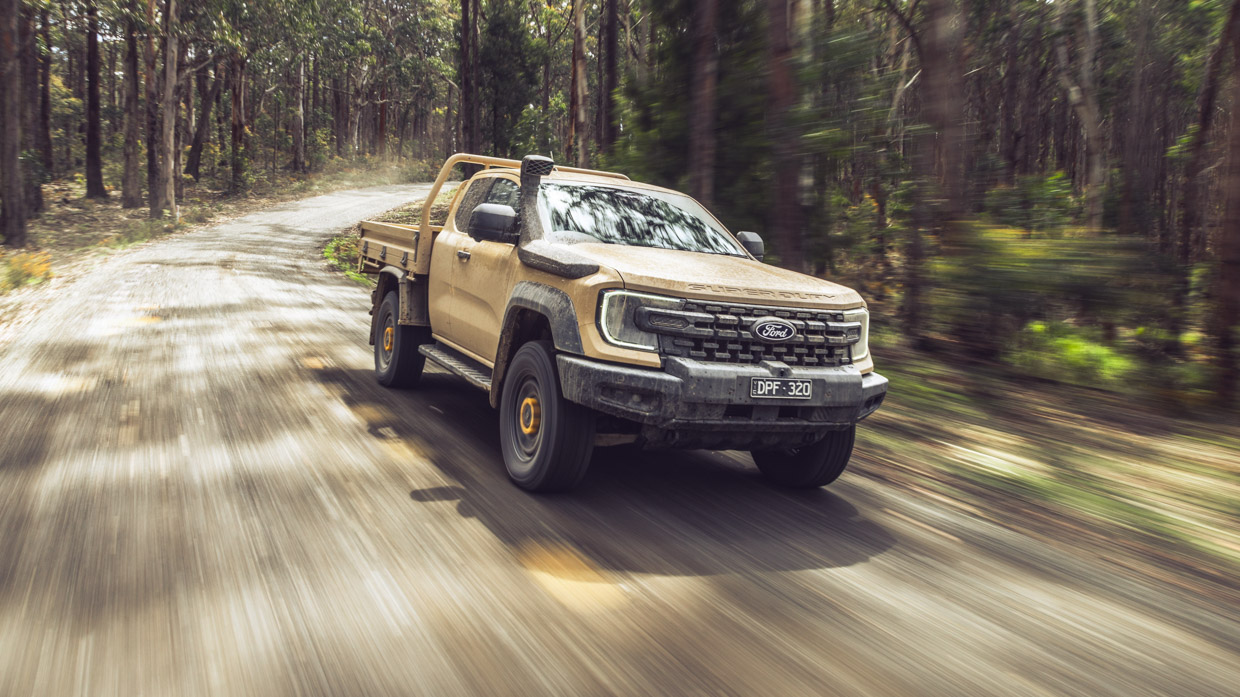
Over-sized mirrors and especially the as-standard Safari snorkel generated wind noise – markedly so at highway speeds – but the all-terrains don’t prove too noisily bothersome. Overall, it feels a well-sealed cabin.
A full suite of driver aids is welcome, and on-road they proved remarkably non-nannying. Intelligent adaptive cruise control, blind spot monitor, cross traffic assist and traffic sign recognition all worked well, but lane keep and lane centring are absolutely best left off on a truck this size.
How about that V6? It’s got decent low-down punch thanks to it retaining the 600Nm of a normal Ranger’s 3.0L, but it is shifting greater mass – a Super Duty’s kerb weight (excluding tray) is between 2518kg and 2675kg, depending on body style. That’s some 200kg over a normal Ranger.

Hold your foot down and the lack of power to move this SD becomes apparent. Only 154kW is offered, down from the V6’s usual 184kW. Ford’s had to give the engine and transmission unique calibrations better suited to heavy duty work, and to meet stricter Heavy Duty Euro6 emissions requirements. You must also pour in AdBlue.
It may not feel like a powerhouse, but really, this is a small compromise when this truck’s towing, payload and off-road clout are considered.
Of note, Ford’s 10-speed auto proved impressively suited. No shortage of cogs for smooth progress and minimal fuss, and it never stuttered in keeping the V6 in the best rev range. But opting for manual control involves daft little buttons on the side of the gear shifter. Surely there’s a better way?
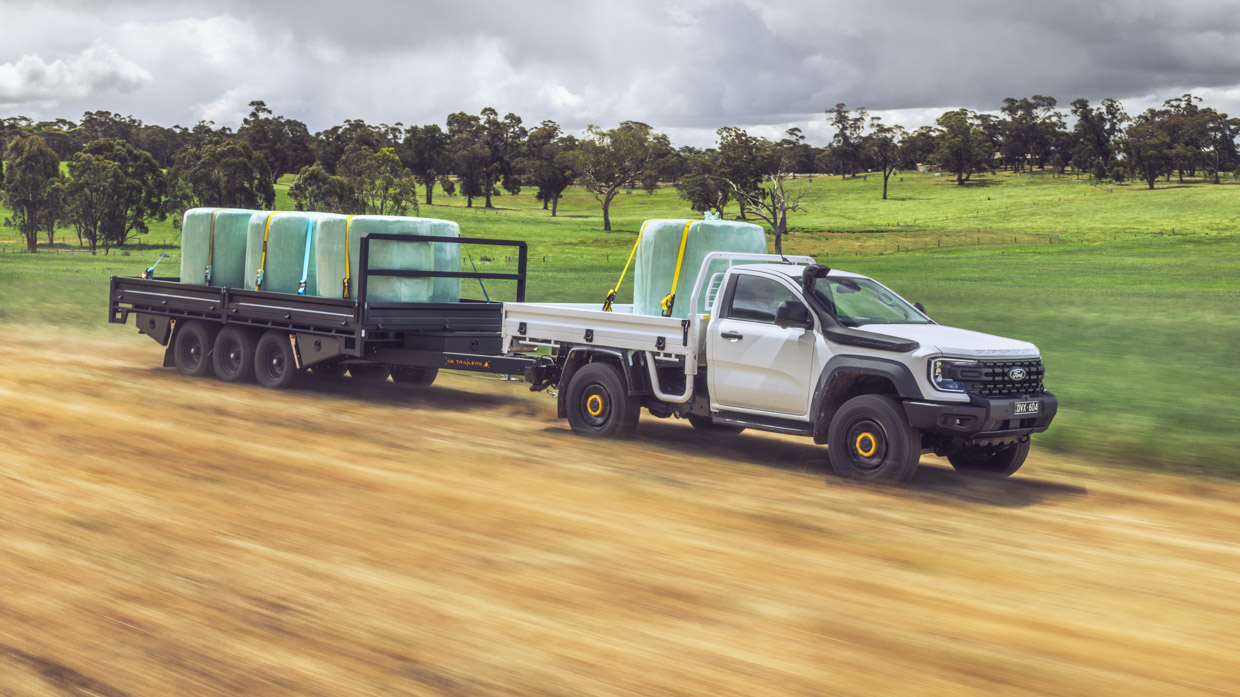
The power deficit won’t be a drama on most journeys, but we did give it the torture test by hauling 4300kg with a loaded trailer and giant (wet) hay bale in the tray.
The Ranger Super Duty maintained its poise and rigidness despite the mass, and side cameras to keep an eye on the trailer’s edges proved excellent.
Merging onto a highway with a slight uphill, you could brew a cuppa in the time it took to reach 100km/h… but we must still appreciate that it’s actually able to haul such mass. The assured, lazy pull of an American V8 would feel best here, but then you’re in a different truck category altogether.

When towing with accelerator planted, our readout maxxed out at 55L/100km. It was drinking hard. Our unladen sealed road test returned 10.8L/100km and the off-road exploring saw 18L/100km.
Ford hasn’t provided an official fuel economy (nor CO2) figure, as it’s not a requirement for a vehicle with such a high GVM. Poor form really; it may not be required, but fleets and private buyers would surely appreciate total disclosure, even if it’s just a baseline L/100km for an unladen example.
Thought has gone into the use cases. There’s a 130L diesel tank and no auto stop/start, while DPF regeneration can be delayed or manually initiated (such as when on the highway) to avoid fire risks in certain environments.

Standard is a 4.5-tonne compatible tow bar and hitch, integrated trailer brake controller, a tow/haul mode as part of selectable drive modes, plus Ford’s Pro Trailer Back-Up Assist where you use a centre console rotary dial to adjust steering while reversing. It’s hands-off steering wheel stuff… weird on first use, but regular tow folk will no doubt appreciate it.
Our off-road odyssey had us summiting and descending Mount Terrible in Victoria’s Great Dividing Ranges. Serious gradients, deep holes, loose surfaces and sharp rocks. Not a place for a soft-core vehicle.
The standard front and rear diff locks can be locked independently, while the differentials themselves – the front is a modified Bronco Super Duty effort – are larger for durability and to handle greater loads.
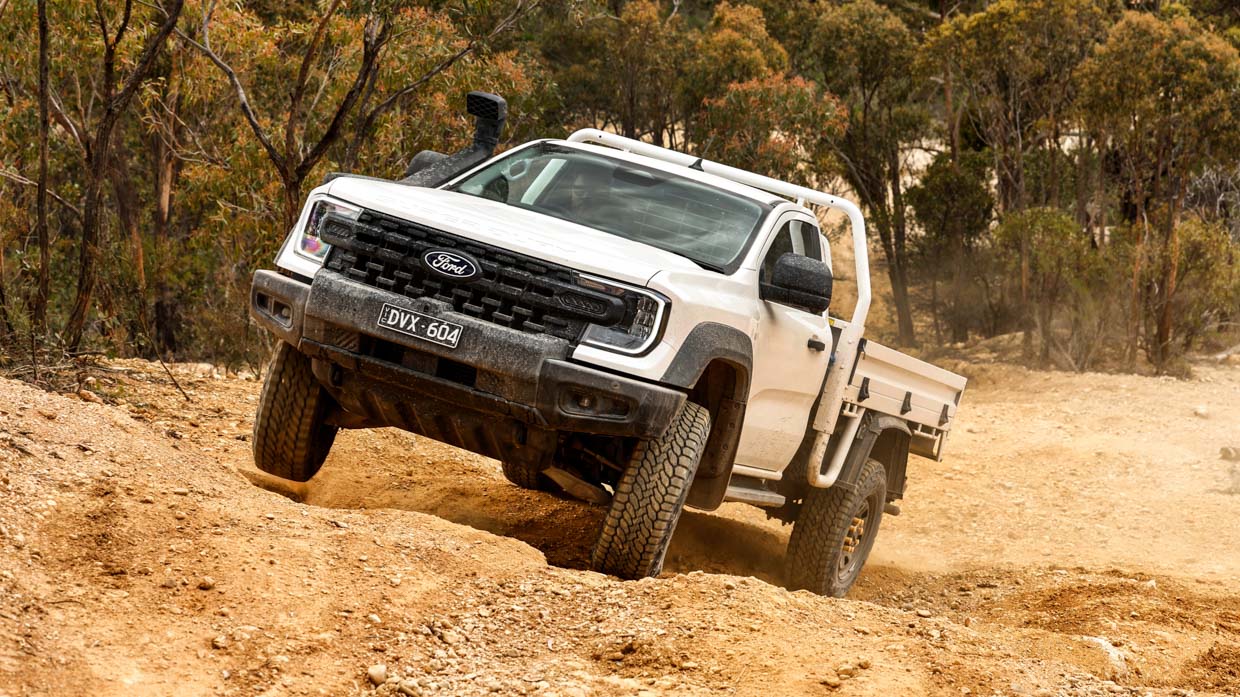
Driveshafts, CV joints, control arms, suspension mounting points, engine mounts, box mount brackets, radiator fan, underbody protection, dual rated front and rear recovery hooks (which are soft shackle compatible), side steps and more are either larger or more reinforced.
A steel front-mounted bumper has mount points ready for accessories, while the wheels – which are fixed with eight studs – are steel 18-inch jobs, chosen over alloys so they can easily be bashed back into shape after taking hits in remote locations. Good.
Tackling Mount Terrible had the SD in its element. Big hits were firmly felt through the cabin, but I’ll put much of this down to 40psi in the tyres. If time had allowed we’d have dropped them to roughly half that, which would have eased the spine shocks.

As expected, the capability, climbing and traction were standout, and I was shocked we didn’t bottom out on some hulking ramps.
A normal Ranger certainly would have, but 299mm ground clearance proved decisive. Approach, departure and ramp break-over angles all help: unladen in the Single Cab-Chassis it’s 36.3, 29.3 and 26.9 respectively.
Next to a LandCruiser 79 Series, the tech and goodies in our Super Duty feel night and day ahead.
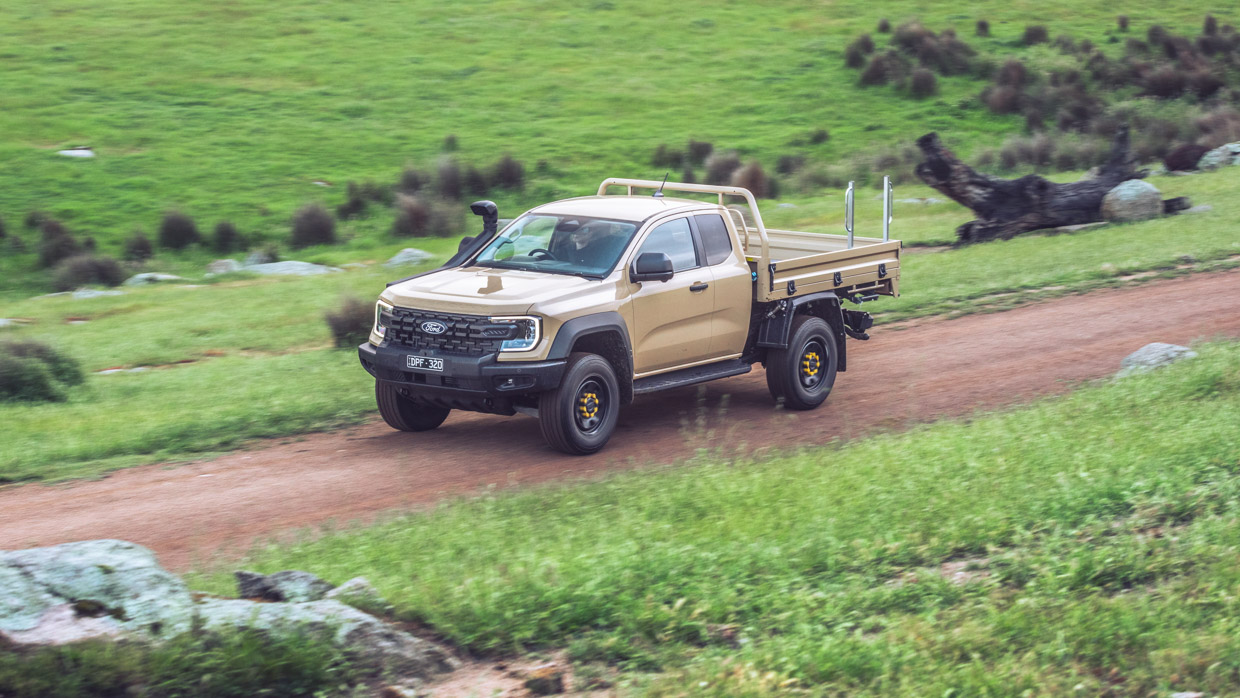
An off-road screen is ideal for monitoring the ground ahead when climbing and occupants can see only sky through the windscreen. There are different drive modes suited to the surface, while hill descent control and Trail Control means you can set descent speed and take feet off all pedals.
On steep drops the brakes neatly pulse to keep control, the 33-inch tyres offer mighty grip, and there are no nasty graunching noises from underneath. It’s deeply impressive and altogether a relaxing way to tackle mountain trails.
It’s a big unit so the turning circle’s hardly Suzuki Jimny-like, but at 13.6m, it’s tighter than a 79 Series’ 14.4m. Helping is a Trail Turn Assist. You hit an on-screen button, and with full lock on it brakes an inside wheel, helping you pivot sharper. Lovely touch.

An extreme off-road course had us exploring the angles our big Ford could reach, but standout for me was the extreme articulation. The massive mounds and cavernous ruts it will clear are brain-bending. Water crossing? Its 850mm wading capability matches that of a Ranger Raptor, and our puddle went over the bonnet yet the big Ford soldiered on.
More tech is found with onboard scales. This smart as-standard safety feature uses sensors mounted to the suspension located at the wheels to provide a payload weight estimate. It’s shown via the cabin’s screen, where it estimates (very accurately, it seems) how close you’re getting to maximum payload. Invaluable for certain applications.
Okay, so capability boxes are ticked. But another trump card our Ford offers over its close-in-price 79 Series rival is cabin equipment. I know, there’s a very sound argument that once you add complication and too much reliance on electronics it’s asking for problems in places complex repairs can’t be done. Wind-down windows over electric ones, and all that.
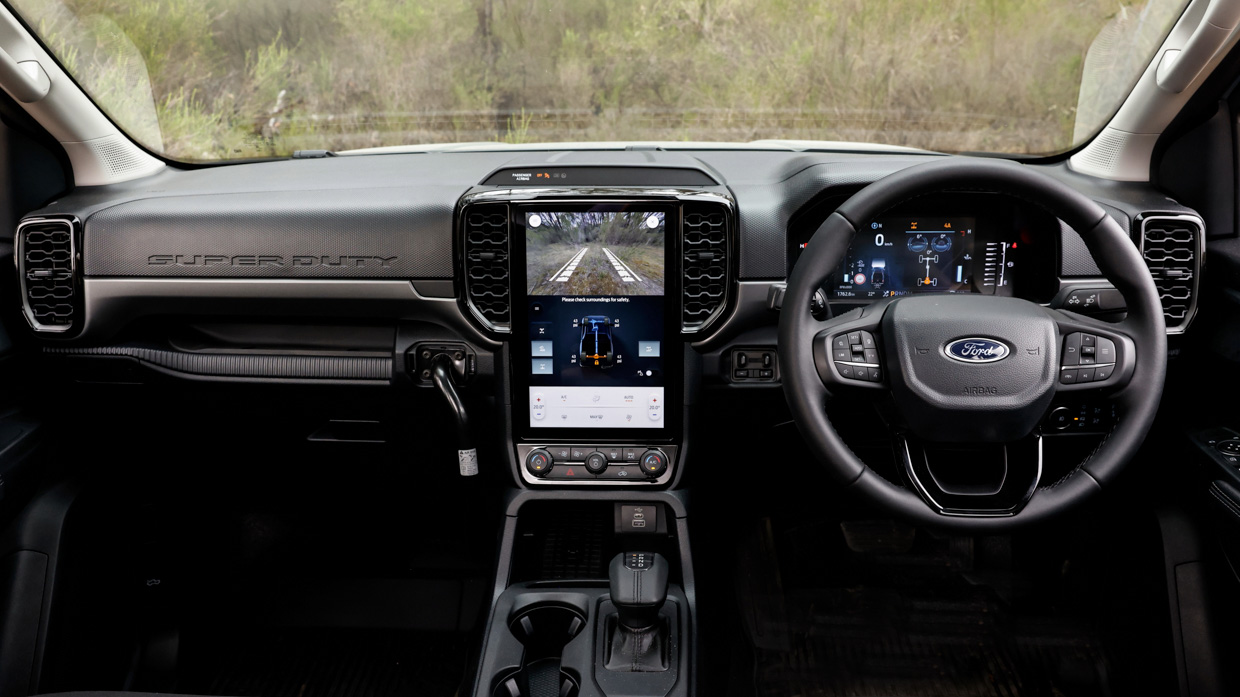

If you don’t subscribe to this belief, or if you don’t deem it relevant, the Super Duty’s cabin is far more humane than that of a Land Cruiser 79 Series or a cab-over engine truck.
It’s a big climb up into the SD’s driver’s seat, and it immediately strikes that it’s not much different to a normal entry-level Ranger, which is a good thing. There is, however, an integrated device mounting system beside the media screen for a work monitor/laptop, while there’s a bank of AUX switches (60A capacity) in the overhead console, and a 400W power inverter.
But interior flashiness begins and ends with the 12-inch vertical infotainment and digital instrument cluster, although there’s the now almost mandatory three USB ports, wireless phone charging, built-in navigation and wireless CarPlay/Android Auto.
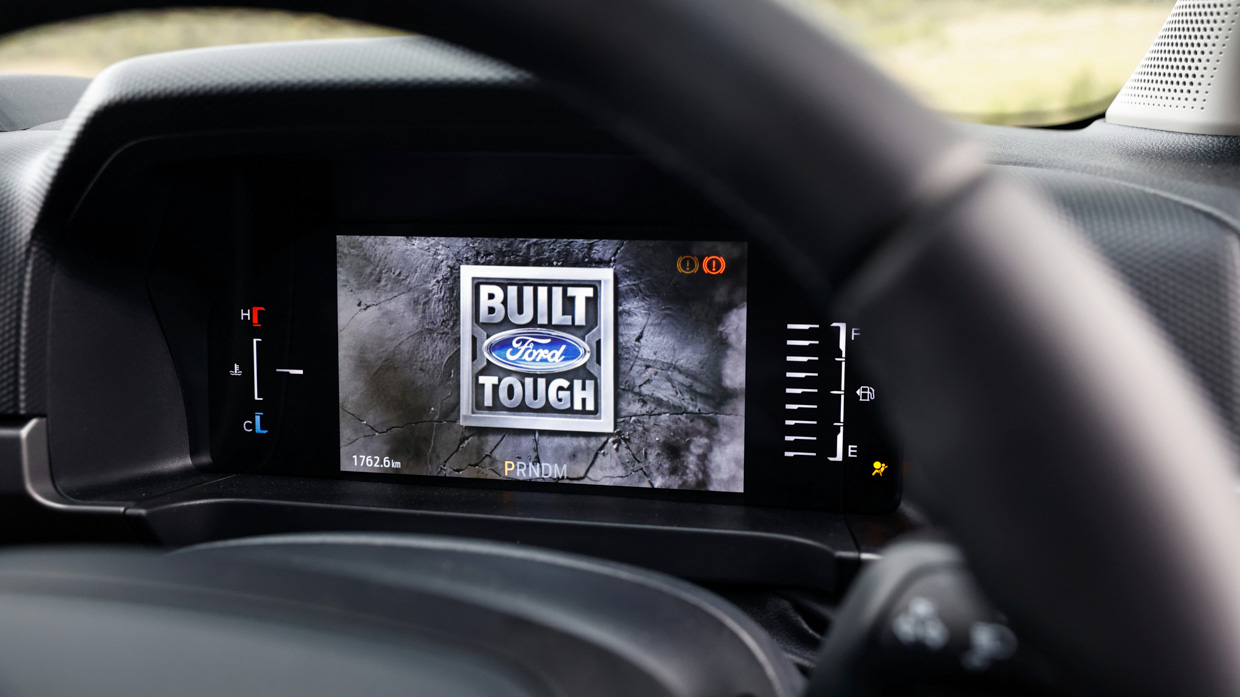

The rest is cloth seats, vinyl floor and lots of hard plastics. Don’t look for power seat adjustment, or for them to be heated or cooled; we must wait for higher grades in future.
Even so, it’s a decent place to spend long journeys considering its truck-like role. But after two solid days in the saddle, I’d really have appreciated some lumbar support for the driver’s seat. Many users will be doing damn long shifts in these chairs.
You’ll choose the body style to suit your work or lifestyle, but if carrying more than two humans, be kind and pick the Double over the Super cab. The latter basically uses stool tops as rear seats, the seat back’s painfully upright, and it’s a real yoga-like mission getting in and out of those tiny hinged doors.
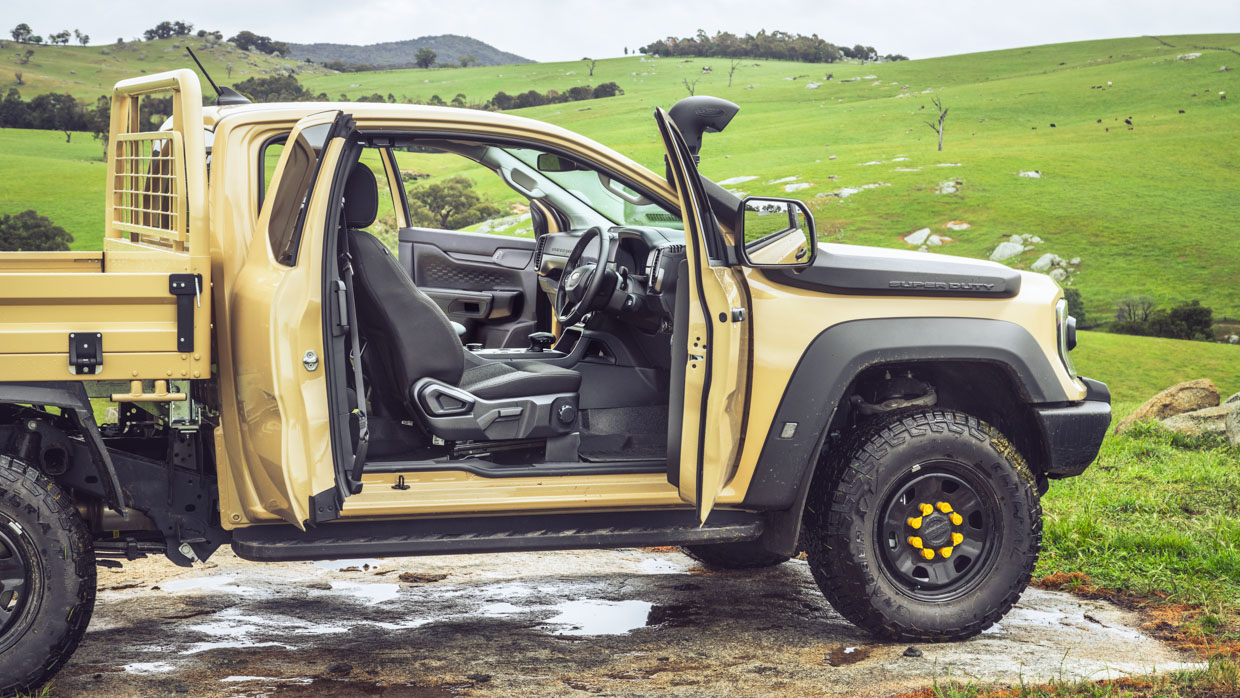
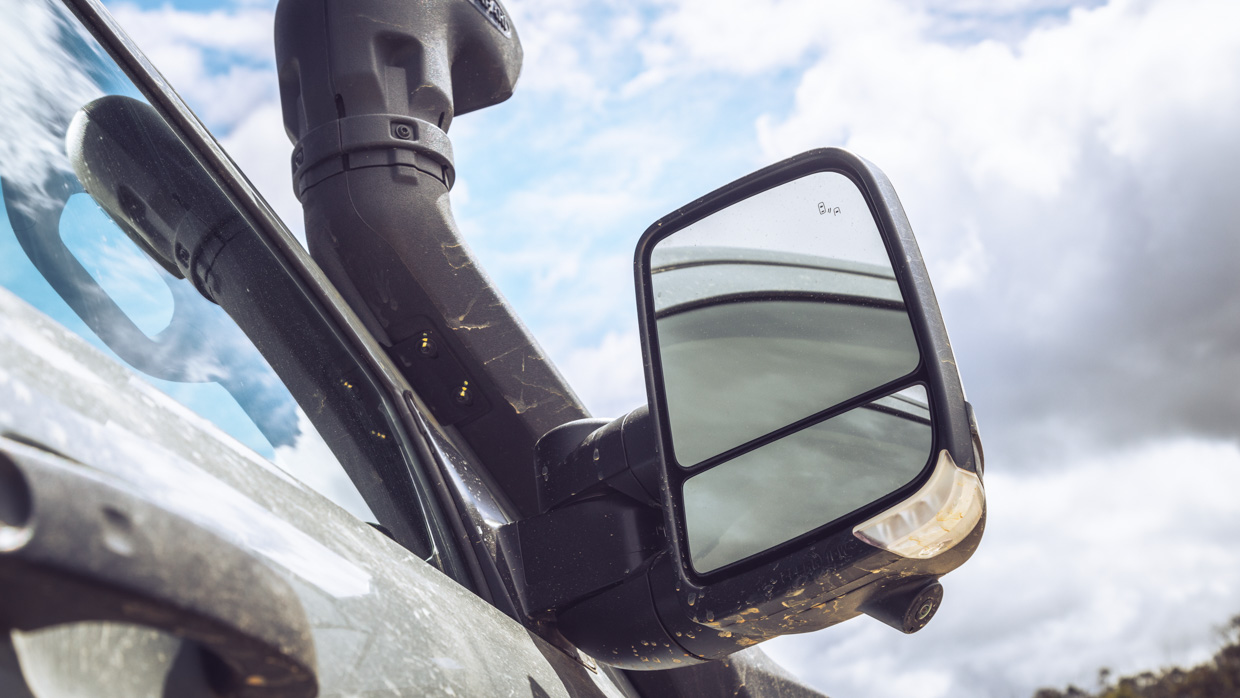
As an aside, highly suited to this Super Duty is Ford’s lengthy range of accessories (rock sliders, dual battery kit, etc.) plus its Pro Convertor program, where convertors (specialised customisations tailored to use) are supported, and their work falls under Ford’s five-year warranty.
In conclusion, it’s impossible not to come away deeply impressed with what Ford offers with its Ranger Super Duty. The towing, hauling, heavy duty engineering and real-world testing are one thing, but the consideration given to this vehicle’s use, and the standard inclusions as a result, show it’s out-the-box ready for work in some of our country’s toughest environments.
The fact it’s relatively comfy, the engine and gearbox combo work well, and safety and connectivity are all as standard, show how tempting the Super Duty will be to fleets and individuals who’d normally default choose the old faithful LandCruiser 79 Series.

But Ford’s V6 must earn its stripes in the field. Doubts around its durability will be tested to extremes by early Super Duty adopters.
If it proves its worth, there’s no question this Ranger will be seen reporting for duty in ever deeper parts of our country’s harshest workplaces.
And, as an ultimate urban flex, expect the style side ute versions to become commonplace on an urban street near you by mid next year. It’s about knowing you can go anywhere, not that you necessarily will.
Key specs (as tested)
About Chasing cars
Chasing Cars reviews are 100% independent.
Because we are powered by Budget Direct Insurance, we don’t receive advertising or sales revenue from car manufacturers.
We’re truly independent – giving you Australia’s best car reviews.
The estimate provided does not take into account your personal circumstances but is intended to give a general indication of the cost of insurance, in order to obtain a complete quote, please visit www.budgetdirect.com.au. Estimate includes 15%^ online discount.
^Conditions Apply
Budget Direct Insurance arranged by Auto & General Services Pty Ltd ACN 003 617 909(AGS) AFSL 241 411, for and on behalf of the insurer, Auto & General Insurance Company Limited(ABN 42 111 586 353, AFSL 285 571).Because we don’t know your financial needs, we can’t advise you if this insurance will suit you. You should consider your needs and the Product Disclosure Statement before making a decision to buy insurance. Terms and conditions apply.
Indicative quote based on assumptions including postcode , 40 year old male with no offences, licence suspensions or claims in the last 5 years, a NCD Rating 1 and no younger drivers listed. White car, driven up to 10,000kms a year, unfinanced, with no modifications, factory options and/or non-standard accessories, private use only and garaged at night.
^Online Discounts Terms & Conditions
1. Discounts apply to the premium paid for a new Budget Direct Gold Comprehensive Car Insurance, Third Party Property Only or Third Party Property, Fire & Theft Insurance policy initiated online on or after 29 March 2017. Discounts do not apply to optional Roadside Assistance.
2. Discounts do not apply to any renewal offer of insurance.
3. Discounts only apply to the insurance portion of the premium. Discounts are applied before government charges, taxes, levies and fees, including instalment processing fees (as applicable). The full extent of discounts may therefore be impacted.
4. We reserve the right to change the offer without notice.